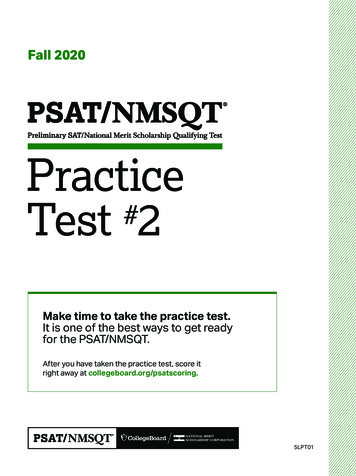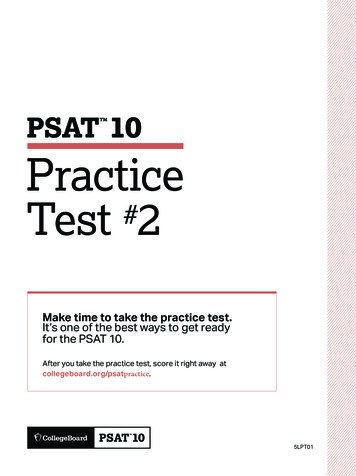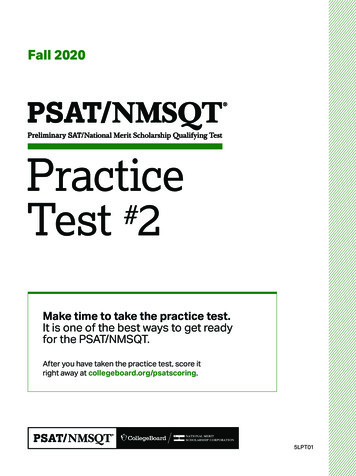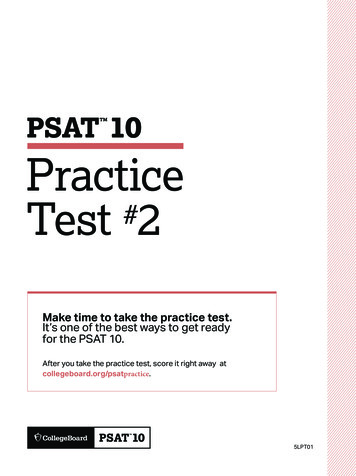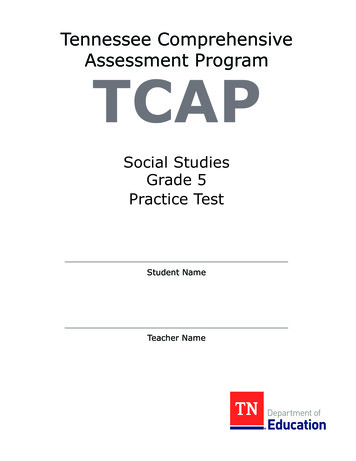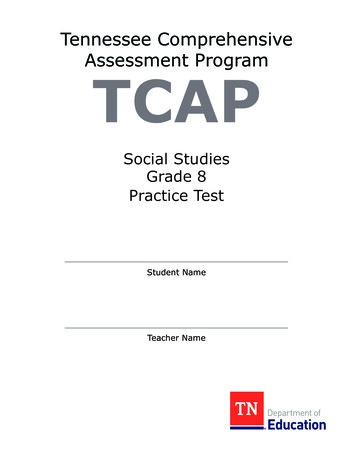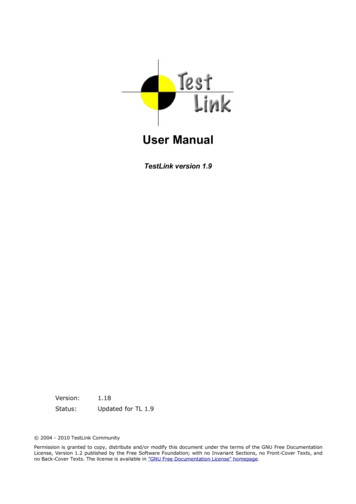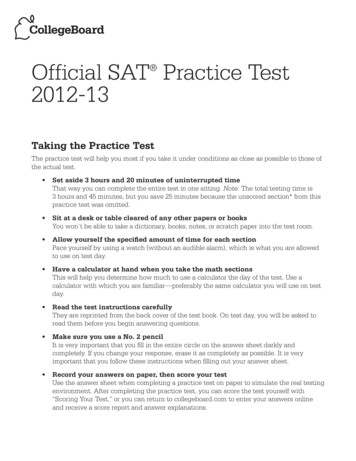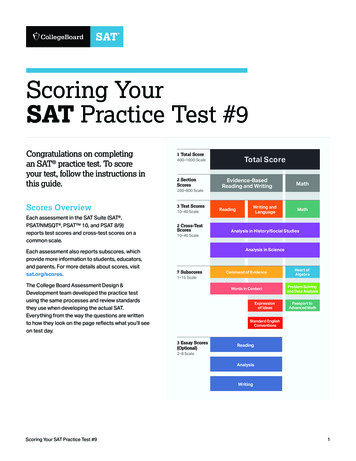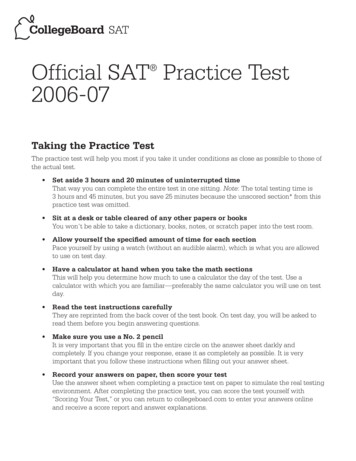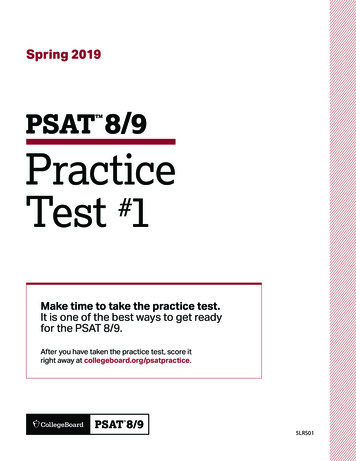
Transcription
Spring 2019PSAT 8/9 Practice#Test 1Make time to take the practice test.It is one of the best ways to get readyfor the PSAT 8/9.After you have taken the practice test, score itright away at collegeboard.org/psatpractice.5LRS01
Test begins on the next page.
11Reading Test55 M I NU TES, 4 2 QUESTIONSTurn to Section 1 of your answer sheet to answer the questions in this section.Each passage or pair of passages below is followed by a number of questions. After readingeach passage or pair, choose the best answer to each question based on what is stated orimplied in the passage or passages and in any accompanying graphics (such as a table orgraph).This passage is adapted from the story “The Flowers ofShiraz” by Goli Taraghi. 2013 by Goli Taraghi. Translation 2013 by Sara Khalili. The passage is set in Tehran, Iran, in1953. The Flowers of Shiraz is a teenage dance group.Gol-Maryam is the schoolmate of the other youngcharacters in the passage.Line510152025Finally, with fear and foreboding, she agrees. Shesays she will come early and leave early.“Maybe I'll come with my father,” she says.“Forget it! Are you nuts? Your dad on a bicycle?With us?”She laughs and hangs up.Wednesday afternoon, right on time, she arrivesat Zafaranieh Street with her chauffeur Javad Agha.She doesn’t have a bicycle. She dismisses Javad Aghaand stands next to me like someone who has neverseen a street, a car, or creatures with two legs. She isafraid of crossing the street, she screams and grabshold of the back of my bicycle. Our group consists ofa few classmates, two of the Flowers of Shiraz (so far,all girls), two of my cousins (boys), and two of theneighborhood guys (Homayoun and Parviz).Gol-Maryam feels out of place. She regrets havingcome, but she has no way back. She is happier withher father. The jokes, the pranks, the screaming andshouting, and everything we talk about is new to her.She doesn’t understand our language. Worst of all,she doesn’t have a bicycle. She climbs up behind me.She fidgets. She’s scared and wants to get off. At thecorner, she jumps off before I have time to stop. Sheloses her balance and falls. We stop. The cousins startgrumbling. Gol-Maryam has scratches on her handsUnauthorized copying or reuse of any part of this page is illegal.Questions 1-8 are based on the following passage.230354045505560and her knee and she is limping. Parviz holds herunder the arm. He takes out his handkerchief andties it around her knee. The Flowers of Shiraz smirkand snicker out of spite and jealousy. Parviz’s bicycleis large. We put Gol-Maryam behind him. She isclumsy and shy and doesn’t know what to do withher hands. She is holding her legs out and away fromthe back wheel and she won’t sit tight against Parviz.I’m sure they will fall. We set off. I hear Gol-Maryamscream, but I don’t look back. We speed down theincline of Baghe Ferdows. Parviz overtakes everyone.Gol-Maryam, her eyes wide with fear and her mouthopen and ready to scream, is staring straight ahead.She has wrapped her arms tight around Parviz’swaist. The wind is blowing through her hair andunder her skirt. The Flowers of Shiraz are stillsmirking. The narrow alley and back roads of Elahiehare filled with pleasant shadows. We stop in front ofAmini Garden. There is a wide stream that flows atthe foot of the garden walls and under the trees. Thewater is cool and clear. It comes from Mrs.Fakhrodolleh’s reservoir. We take off our shoes, putour feet in the stream, and wash our face and hands.Gol-Maryam’s face is flushed and she’s panting. Shepats some water on her face and then she, too, takesoff her shoes and dips her feet in the stream.The Flowers of Shiraz splash water on each other andchase after one another. It is a pleasant game on sucha hot day. Gol-Maryam hides behind a huge tree.I think she will start crying any minute now. But no.She hops from behind one tree to the next andsplashes water on Parviz and laughs.We ride out to Rumi Bridge and turn back. Wemake plans to go to Tajrish Bridge on Friday night.CO NTI N U E
1Which choice best describes a main theme of thepassage?A) Courage emerges when close friends are near.B) Trust is the basis upon which friendships arebuilt.C) It is easier for one to choose what is comfortableinstead of what the majority wants.D) Facing one’s fears leads to new and meaningfulexperiences.2The author includes the conversation in lines 1-6(“Finally . . . hangs up”) most likely toA) create a tense mood by showing thatGol-Maryam’s decisions are in contrast to herfather’s advice.B) set the scene by revealing that Gol-Maryam isnot comfortable with what she is about to do.C) lay a foundation for the plot by explaining whyGol-Maryam is uneasy around other people.D) introduce the setting to provide context forGol-Maryam’s actions.3Which choice best supports the idea thatGol-Maryam “feels out of place” (line 17) whenshe is with her schoolmates?A) Lines 19-20 (“The jokes . . . her”)B)Lines 23-24 (“At the corner . . . stop”)C) Lines 25-27 (“The cousins . . . limping”)D) Lines 53-55 (“The Flowers . . . tree”)Unauthorized copying or reuse of any part of this page is illegal.1134According to the passage, The Flowers of Shirazmock Gol-Maryam becauseA) she does not know how to swim.B) they resent and envy her.C) she does not have a bicycle.D) they dislike her family.5As used in line 37, “overtakes” most nearly meansA) frightens.B) passes.C) surprises.D) tricks.6As used in line 38, “eyes wide with fear” moststrongly suggests that Gol-MaryamA) is worried about getting in trouble with herfather.B) has a look of excitement on her face.C) can see danger that others cannot.D) is startled and anxious about what is happening.CO NTI N U E
1At the end of the passage, it can reasonably beinferred that the narratorA) is surprised by Gol-Maryam’s playfulness.B) is angry that Gol-Maryam is splashing Parviz.C) realizes that Gol-Maryam was only pretending tobe afraid.D) feels bad that the girls had misjudgedGol-Maryam’s character.8Which choice provides the best evidence for theanswer to the previous question?A) Line 31 (“We put . . . him”)B)Lines 42-43 (“The Flowers . . . smirking”)C) Line 56 (“I think . . . no”)D) Lines 57-58 (“She hops . . . laughs”)Unauthorized copying or reuse of any part of this page is illegal.714Questions 9-16 are based on the followingpassage and supplementary material.This passage is adapted from Patrick Tucker, “TheOver-Mediated World.” 2007 by The World Future Society.Line51015202530354045The average American spends more time usingmedia—an iPod, computer, radio, television,etc.—than in any other wakeful activity, almost ninehours a day. Ubiquitous news, e-mail, andentertainment are facts of modern life and, notsurprisingly, most of us feel that convenient andconsistent access to the digital world is a good thing.But what if our new “connected age” is actuallypushing us further apart, making us not moreinformed, but less so? This is the concern ofMichael Bugeja, director of the Greenlee School ofJournalism and Communication at Iowa StateUniversity and author of Interpersonal Divide: TheSearch for Community in the Technological Age(Oxford, 2005).“Family time at the dinner table used to besacrosanct. Nutritionists and psychologists will tellyou that having dinner together uninterrupted is agood thing. We moved from that to ‘quality time,’where both parents were working. Now we’ve gonefrom family time to quality time to media time, ordefining activities around media. We spend timetogether by using media in proximity to one another,in the same house or in the same car, but the mediaitself is often separate,” says Bugeja. By way ofexample, he points to the common sight of parentsdriving and talking on their cell phones while theirkids sit in the backseat and watch a DVD.“The more we use technology, the less time wehave to nurture our primary relationships,” saysBugeja. “The reason is simple: Communicationssystems alter value systems. We’re spending moretime communicating via social networks, ignoringthose in our immediate environment. Meanwhile,television viewing devours leisure time. Of coursewe’re lonely most of the day. We’re searching formeaningful relationships in front of screens andmonitors.”The amount of time we spend immersed in themedia environment affects the way we behave andinteract outside of that space. Students who havewireless capability on their laptops feel more entitledto log onto social networking Web sites duringlectures. The intern who has a video game loadedonto his cell phone is most likely to be the oneCO NTI N U E
15560playing the game under the table during animportant meeting. The harried professional is moreinclined to take a call in the middle of a concert,during dinner, or at some other inappropriate time.Media, in its very availability, invites abuse,according to Bugeja. When such techno-abusesbecome commonplace they cease to be taboo, aphenomenon Bugeja refers to as “digitaldisplacement.”He describes digital displacement as whathappens when the demands of the real world conflictwith those of the virtual, resulting in too manypeople paying too much attention to gadgets andignoring reality, such as drivers interfacing withnavigation computers instead of looking out forpedestrians.5016570While Bugeja doesn’t imagine the situation willchange quickly or easily, he does acknowledge that asolution exists. “The key is to nurture interpersonalintelligence,” he says. “That’s the ability to knowwhen, where, and for what purpose technology isappropriate or inappropriate. I don’t believe thisis a problem of the emerging generation. I thinkthis is a problem of the profiteers of new media. Ibelieve the solution is, as it’s always been in thiscountry, education and information.”Time Spent (in minutes) with Media per Person per Day400Mean time RaesmaGicusMAdapted from Robert A. Papper et al., “Middletown Media Studies.” 2004 byInternational Digital Media & Art Association.Unauthorized copying or reuse of any part of this page is illegal.5CO NTI N U E
1The main idea of the passage is thatA) social media are helping people replace oldrelationships with new ones.B) media are causing people to interact less withothers in the real world.C) social media are affecting the way in whichyoung people relate to adults.D) media are helping people establish relationshipswith people all around the world.10The author uses the example in lines 25-28(“By way . . . DVD”) mainly to support the assertionthat families todayA) are spending time together in less meaningfulways than they used to.B) no longer spend time with each other in thesame house.C) are finding positive ways to include media in thetime they spend together.D) no longer have dinner together without theintrusion of technology.11Which choice provides the best evidence for theanswer to the previous question?A) Lines 17-19 (“Nutritionists . . . thing”)B)Lines 19-20 (“We moved . . . working”)C) Lines 20-22 (“Now . . . around media”)D) Lines 35-36 (“Of course . . . day”)12As used in line 30, “primary” most nearly meansA) guiding.B) extremely basic.C) original.D) most important.Unauthorized copying or reuse of any part of this page is illegal.91613As used in line 35, “devours” most nearly meansA) affects.B) consumes.C) destroys.D) overcomes.14In the passage, Michael Bugeja indicates thatA) media are inappropriate to use except in anemergency situation.B) future generations will know better how togenerate income from media.C) teachers find it useful to have students use mediafor learning in a classroom setting.D) people are focused more on media than on theirimmediate surroundings.15Which choice provides the best evidence for theanswer to the previous question?A) Lines 39-41 (“The amount . . . space”)B)Lines 50-51 (“Media . . . Bugeja”)C) Lines 55-61 (“He describes . . . pedestrians”)D) Lines 68-69 (“I think . . . media”)16According to the graph, on average, a person spendsmore time per day using the Internet thanA) watching television.B) reading.C) listening to the radio.D) playing games.CO NTI N U E
1This passage is adapted from Charles Q. Choi, “Strange LifeFound in Underwater Caves.” 2013 by TechMediaNetwork.Line5101520Clues to how life evolved, not only on this planetbut also possibly on alien worlds, might be found inunderwater caves in the Bahamas, researchers say.The caves in question are called “blue holes,”so-named because from the air, their entrancesappear circular in shape, with different shades of bluewater in and around them. There are estimated to bemore than 1,000 such caves in the Bahamas, thegreatest concentration of blue holes in the world.“It’s really incredible to be swimming down apassage that no one has ever been in before, toexperience that thrill of discovery,” said researcherTom Iliffe, a marine biologist at Texas A&MUniversity at Galveston. “At the bottom of a cave,there’s no telling what might be around the nextcorner.”Iliffe and his colleagues examined three inlandblue holes in the Bahamas. They discovered thatlayers of bacteria exist in all three, but each of thesewater-filled sinkholes had significantly differentmicrobes living in them from the others.“We’re finding new forms of life that aretotally unknown elsewhere on Earth,” Iliffe toldOurAmazingPlanet.Blue hole bacteria25303540Within each blue hole, the microbes theresearchers found varied depending on the depth,owing to how the water in them was separated intodistinct fresh- and saltwater layers as well asoxygen-poor or virtually completely oxygen-depletedlayers. The blue holes also varied from each otherdue to differences such as food sources.“We examined two caves on Abaco Island andone on Andros Island,” Iliffe said. “One on Abaco, ata depth of about 100 feet (30 meters), had sheets ofbacteria that were attached to the walls of the caves,almost one inch (2.5 centimeters) thick. Anothercave on the same island had bacteria living withinpoisonous clouds of hydrogen sulfide at theboundary between fresh- and saltwater. These caveshad different forms of bacteria, with the types anddensity changing as the light source from above grewdimmer and dimmer.”Unauthorized copying or reuse of any part of this page is illegal.Questions 17-25 are based on the followingpassage and supplementary material.174550“In the cave on Andros, we expected to findsomething similar, but the hydrogen sulfide layerthere contained different types of bacteria,” Iliffeadded. “It shows that the caves tend to have lifeforms that adapt to that particular habitat, and wefound that some types of the bacteria could live inenvironments where no other forms of life couldsurvive. This research shows how these bacteria haveevolved over millions of years and have found a wayto live under these extreme conditions.”‘Natural laboratories’5560657075The fact that each cave has different conditionsfrom the others and thus a different palette of lifehelps scientists analyze the diverse routes life mighthave taken on Earth, given slight tweaks in theirinitial brews.“These bacterial forms of life may be similar tomicrobes that existed on early Earth and thusprovide a glimpse of how life evolved on this planet,”Iliffe explained. “These caves are natural laboratorieswhere we can study life existing under conditionsanalogous to what was present many millions ofyears ago.”Specifically, “these caves have no light andtherefore no photosynthetic production of oxygen,which means the dissolved oxygen levels are eitherlow or nonexistent, similar to the environments thatprobably existed on the early Earth,” Iliffe said.These findings might also shed light on how lifemight have developed on distant planets and moons.“As far as we know, no surface waters currentlyexist anywhere else in our solar system, but theremight be water beneath the surface, say on Mars ormoons like Europa,” Iliffe said. “These are areas oftotal darkness, and so the caves on Earth we areexploring might be similar.”CO NTI N U E
11Bacterial Cells per Milliliter in a Blue Hole(Lucayan Caverns, Grand Bahama Island, Bahamas)Sample locationDepth belowwater surface(m)Wateradjacent tocave wallRock core at a distance into cave wall of2.0 cm4.0 cm6.0 cm8.0 514.0(freshwater/salt water mix)88,0241,321,295325,61133,45819,75615.9(salt water)157,326510,504193,64275,78723,291Adapted from S. J. Schwabe, R. Herbert, and J. L. Carew, “A Hypothesis for Biogenic Cave Formation:A Study Conducted in the Bahamas.” 2008 by Gerace Research Center.Which statement best describes the overall structureof the passage?A) The author describes a discovery in underwatercaves, and then explains why the discovery isimportant.B) The author presents an argument for conductingadditional research in underwater caves, andthen gives evidence to support the argument.C) The author presents a series of events that occursin underwater caves, and then describes how theevents are related.D) The author describes a phenomenon found inunderwater caves, and then explains what causedthe phenomenon.Unauthorized copying or reuse of any part of this page is illegal.17818Based on the passage, Iliffe’s perspective on studyingthe blue holes is that it isA) challenging to understand why the water in thecaves has such unique properties.B) perplexing to find so many strange life-forms inunexpected places.C) dangerous to venture into unexplored territories.D) exciting to explore the unknown.19What does Iliffe’s use of the phrase “sheets ofbacteria” (lines 34-35) suggest about the blue hole?A) There was a limited variety of bacterial forms inthe blue hole.B) There was a great amount of bacteria in theblue hole.C) The bacteria in the blue hole were compressed atdeep levels.D) The bacteria in the blue hole had multiple layersof food supplies.CO NTI N U E
1Which choice best supports the conclusion thatdifferent types of bacteria in the deeper layers of blueholes have adapted to varying levels of darkness?A) Lines 25-30 (“Within . . . layers”)B)Lines 36-39 (“Another . . . saltwater”)C) Lines 39-42 (“These . . . dimmer”)D) Lines 53-56 (“The fact . . . Earth”)21As used in line 52, “extreme” most nearly meansA) outermost.B) severe.C) thrilling.D) ultimate.22According to the passage, blue holes could helpreveal how life may have evolved on this planetbecause the bacteria in the blue holesA) can live in complete darkness.B) can survive without food sources.C) cannot survive without some form of air.D) cannot be found anywhere else in the world.23Which choice provides the best evidence for theanswer to the previous question?A) Lines 43-46 (“In the cave . . . added”)B)Lines 58-61 (“These bacterial . . . explained”)C) Lines 65-69 (“Specifically . . . said”)D) Lines 72-75 (“As far . . . said”)Unauthorized copying or reuse of any part of this page is illegal.201924Based on the table, which of the following supportsthe greatest bacterial growth?A) Salt water adjacent to the cave wallB) A mix of freshwater and salt water adjacent tothe cave wallC) A distance of 2.0 cm into the cave wall at a depthwhere freshwater and salt water mixD) A distance of 8.0 cm into the cave wall at a depthwhere there is only freshwater25Which idea from the passage is supported by theinformation in the table?A) Bacteria in blue holes differ from one anotherdue to varying food sources.B) Bacteria have evolved over millions of years.C) The density of the bacteria varies across waterdepths in blue holes.D) The types of bacteria living in each blue holediffer significantly.CO NTI N U E
1This passage is adapted from Nelson Mandela’s presidentialinaugural address, delivered on May 10, 1994. For manyyears, Mandela led a peaceful and nonviolent campaignagainst the South African government and its policies ofracial oppression.Line510152025303540Today, all of us do, by our presence here, and byour celebrations in other parts of our country and theworld, confer glory and hope to newborn liberty.Out of the experience of an extraordinary humandisaster that lasted too long, must be born a societyof which all humanity will be proud.Our daily deeds as ordinary South Africans mustproduce an actual South African reality that willreinforce humanity’s belief in justice, strengthen itsconfidence in the nobility of the human soul andsustain all our hopes for a glorious life for all.All this we owe both to ourselves and to thepeoples of the world who are so well represented heretoday.To my compatriots, I have no hesitation in sayingthat each one of us is as intimately attached to thesoil of this beautiful country as are the famousjacaranda trees of Pretoria and the mimosa trees ofthe bushveld.Each time one of us touches the soil of this land,we feel a sense of personal renewal. The nationalmood changes as the seasons change.We are moved by a sense of joy and exhilarationwhen the grass turns green and the flowers bloom.That spiritual and physical oneness we all sharewith this common homeland explains the depth ofthe pain we all carried in our hearts as we saw ourcountry tear itself apart in a terrible conflict, and aswe saw it spurned, outlawed and isolated by thepeoples of the world, precisely because it has becomethe universal base of the pernicious ideology andpractice of racism and racial oppression.We, the people of South Africa, feel fulfilled thathumanity has taken us back into its bosom, that we,who were outlaws not so long ago, have today beengiven the rare privilege to be host to the nations ofthe world on our own soil. . . .The time for the healing of the wounds has come.The moment to bridge the chasms that divide ushas come.The time to build is upon us.Unauthorized copying or reuse of any part of this page is illegal.Questions 26-34 are based on the followingpassage.1104550556065707580We have, at last, achieved our politicalemancipation. We pledge ourselves to liberate all ourpeople from the continuing bondage of poverty,deprivation, suffering, gender and otherdiscrimination.We succeeded to take our last steps to freedom inconditions of relative peace. We commit ourselves tothe construction of a complete, just and lasting peace.We have triumphed in the effort to implant hopein the breasts of the millions of our people. We enterinto a covenant that we shall build the society inwhich all South Africans, both black and white, willbe able to walk tall, without any fear in their hearts,assured of their inalienable right to humandignity—a rainbow nation at peace with itself and theworld.As a token of its commitment to the renewal ofour country, the new Interim Government ofNational Unity will, as a matter of urgency, addressthe issue of amnesty for various categories of ourpeople who are currently serving terms ofimprisonment.We dedicate this day to all the heroes andheroines in this country and the rest of the worldwho sacrificed in many ways and surrendered theirlives so that we could be free.Their dreams have become reality. Freedom istheir reward.We are both humbled and elevated by the honourand privilege that you, the people of South Africa,have bestowed on us, as the first President of aunited, democratic, non-racial and non-sexist SouthAfrica, to lead our country out of the valley ofdarkness.We understand it still that there is no easy road tofreedom.We know it well that none of us acting alone canachieve success.We must therefore act together as a united people,for national reconciliation, for nation building, forthe birth of a new world.CO NTI N U E
1The main purpose of the passage is toA) convince the South African people to support anew form of government.B) reprimand other countries for abandoningSouth Africa in a time of great need.C) remember the hardships the South Africanpeople overcame to secure freedom.D) encourage the South African people to cometogether in rebuilding their nation.27Which choice best summarizes the passage?A) Humankind is capable of evil under oppressionand greatness when granted freedom.B) It was the sacrifices of ordinary citizens thatended the conflict in the nation of South Africa.C) Although racial oppression wounded thecountry of South Africa, a new season of peaceand liberty will heal it.D) Although nations across the globe promised towork together to put an end to racism, manycountries failed to respond to South Africa’s pleafor help.28Mandela includes the statement in lines 4-6 mostlikely to convey the idea thatA) time will eventually heal the wounds of SouthAfrica’s broken society.B) extraordinary South African heroes haveemerged from extraordinary hardships.C) the best way to overcome disaster is to resist theurge to focus on South Africa’s past.D) South African society must learn from its failingsin order to shape a better future.Unauthorized copying or reuse of any part of this page is illegal.26129Mandela implies that for the nation to achieve itspotential, it is most important thatA) the South African people regain confidence intheir political system.B) the South African people live each day withintegrity.C) other countries send representatives to makepeace with South Africa.D) other countries recognize South Africa as a freecountry.30Which choice provides the best evidence for theanswer to the previous question?A) Lines 7-11 (“Our . . . for all”)B)Lines 12-14 (“All . . . today”)C) Lines 33-37 (“We, the people . . . soil”)D) Lines 42-43 (“We have . . . emancipation”)31As used in line 23, “moved” most nearly meansA) changed.B) stirred.C) relocated.D) postponed.32Mandela’s purpose for repeating the phrases “thetime” and “has come” in lines 38-41 is most likely toA) suggest that building something new will causefaster healing.B) reinforce the claim that old wounds must behealed before people can move forward.C) emphasize the idea that the time for action is thepresent.D) contrast the difference between times of war andtimes of peace.CO NTI N U E
1Based on the passage, which choice most closelydescribes Mandela’s perspective on freedom?A) Freedom is a privilege people earn, not a rightthey have from birth.B) Freedom is not easily attainable, but it is worthfighting for.C) The freedom enjoyed in times of peace must besacrificed in times of war.D) The freedom of a nation is more important thanthe freedom of individuals.34Which of the following does Mandela suggest is mostimportant to ensuring South Africa’s continuedprogress?A) Unity among the peopleB) Pride in the landC) Celebration of fallen heroes and heroinesD) Investigation of past wrongsUnauthorized copying or reuse of any part of this page is illegal.33112Questions 35-42 are based on the followingpassages.Passage 1 is adapted from Lori J. Keesey, “Blacker ThanBlack.” Published December 2010 on NASA’s website.Passage 2 is adapted from Clifford A. Pickover, The PhysicsBook: From the Big Bang to Quantum Resurrection, 250Milestones in the History of Physics. 2011 byClifford A. Pickover.Passage 1Line5101520253035Black is black, right? Not so, according to a teamof NASA engineers now developing ablacker-than-pitch material that will help scientistsgather hard-to-obtain
Front Cover Spring 2019 PSAT 8/9 . Practice Test # 1. Make time to take the practice test. It is one of the
